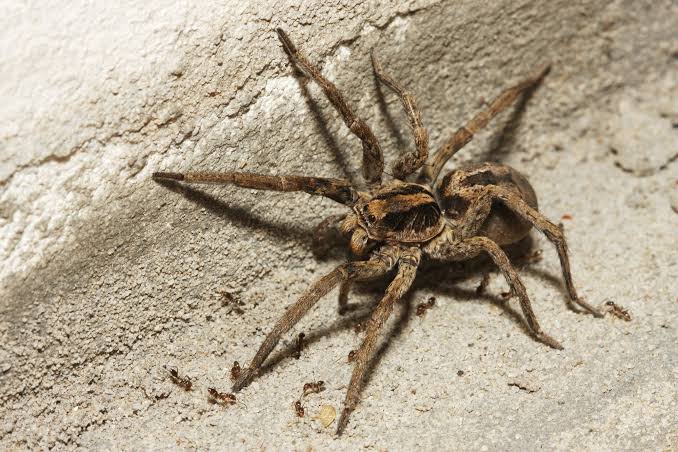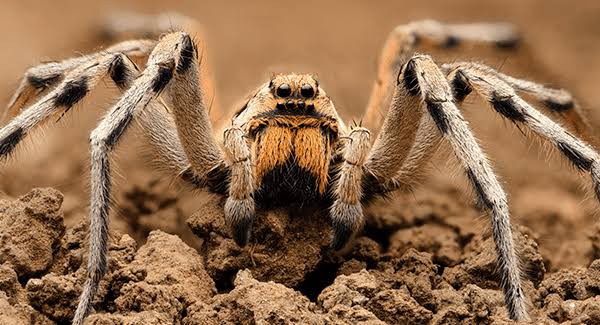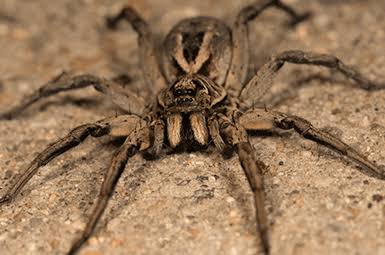The Wolf spider is a kind of spider that lives in many places around the world. It’s not like other spiders that make webs to catch food. Instead, the Wolf spider hunts for its food. They have eight legs and furry bodies, which make them a bit scary for some people, but they’re interesting creatures!
These spiders are great hunters. They use their quickness and strong legs to chase after their prey. Their eyesight is good too, helping them to find their food. They eat insects like crickets, ants, and even other spiders. Sometimes, they hide and wait for their prey to come closer, then pounce on it!
Wolf spiders are not picky about where they live. You might find them in gardens, forests, grasslands, or even in your house! They are adaptable and can live in many different environments. Some of them make burrows in the ground where they hide during the day and come out at night to hunt.
What’s interesting is that Wolf spiders carry their babies on their backs. The mommy spider keeps her babies safe until they’re old enough to take care of themselves. This is quite unique in the spider world!
One thing that might surprise you is that Wolf spiders are not harmful to humans. They might look scary, but they are not dangerous. They only bite if they feel threatened, and their bites are not usually harmful, just a bit like a bee sting.
These spiders play an essential role in controlling insect populations. By eating other bugs, they help keep the balance in nature. They are part of the ecosystem, just like other animals. In addition, the Wolf spider might seem a bit scary, but they are fascinating creatures. They hunt their prey, carry their babies, and help keep the insect population in check. They are not harmful to humans and are an essential part of our natural world.
These spiders have a unique way of capturing their food. Instead of spinning webs, they use their silk to create retreats or burrows where they can rest or hide. Sometimes, they lay down a silk trail to find their way back home after hunting. This silk isn’t sticky like the webs of other spiders, but it’s strong and useful for them in many ways.
The Wolf spider is quite a solitary creature, preferring to live alone rather than in groups. They don’t like sharing their space with other spiders, and they can even fight to protect their territory. This independence is a notable aspect of their behavior.
Their size can vary, but they’re generally not enormous spiders. Some might have bodies around half an inch, while others could be a bit bigger. Their colors can range from gray to brown or even black, which helps them blend into their surroundings.
Interestingly, these spiders don’t use venom to catch their prey. Instead, they overpower their food using their strong legs and sharp fangs. They’re quite agile and quick, which gives them an advantage while hunting. Their bite might be a bit scary, but it’s primarily meant for their dinner, not for humans.
In many cultures, Wolf spiders have different meanings. Some see them as symbols of patience and resourcefulness. Others might find them a sign of mystery or even fear. However, these creatures are just trying to survive like any other living being.
Overall, the Wolf spider is an intriguing species with unique habits and characteristics. Despite their appearance, they contribute positively to nature by keeping insect populations in check.
Read Also: Find out which of the Ruminant Breeds is better to raise
Appearance and Features of the Wolf Spiders

Wolf spiders have some distinctive features that set them apart from other spiders.
They have eight legs like most spiders, but what makes them stand out are their robust and hairy bodies. These hairs can vary in color and thickness, but they give Wolf spiders a sort of fuzzy appearance. Their bodies are divided into two parts: the cephalothorax (head and thorax combined) and the abdomen.
Their eyes are also quite remarkable. They typically have eight eyes arranged in three rows. Two large eyes sit at the front, giving them better vision than many other spiders. This keen eyesight helps them in hunting and navigating their surroundings.
The size of a Wolf spider can differ, but they’re generally not the biggest spiders around. They’re more on the medium-sized spectrum compared to other spider species. Some may have bodies that are around half an inch, while others might be slightly larger.
Their coloring is often earthy, blending in with their surroundings. They can be brown, gray, or even black, which aids them in camouflaging and staying hidden from predators.
Their legs are strong and agile, allowing them to move swiftly and catch their prey. They use their speed rather than trapping insects in webs, making them skilled hunters. And unlike some other spiders, Wolf spiders are not known for spinning intricate webs. Instead, they use silk for different purposes like lining their burrows or wrapping their eggs.
These spiders are quite fascinating in appearance and behavior, making them a unique species among arachnids.
History and Origin of the Wolf Spiders
The history and origin of Wolf spiders trace back through time, existing in various parts of the world for a long while.
These spiders belong to the Lycosidae family, which is an ancient group of spiders that have been around for millions of years. The name “Lycosidae” comes from the Greek word “lykos,” meaning wolf, which is fitting considering their hunting behavior and their somewhat wolf-like appearance.
Their evolutionary history dates back to prehistoric times when they developed unique traits that helped them survive and thrive in diverse habitats. Over time, they’ve adapted to different environments, which is why you can find various species of Wolf spiders in different regions worldwide.
As for their distribution, Wolf spiders can be found on almost every continent, except Antarctica. They’re quite adaptable and can live in different climates, ranging from forests and grasslands to deserts and even urban areas. Their ability to adapt has allowed them to spread and establish populations in various places around the globe.
Throughout history, these spiders have been a part of various cultures and myths. They’ve been featured in stories, folklore, and even some ancient beliefs, often representing different things like patience, stealth, or even fear in different societies.
Their resilience, adaptability, and unique characteristics have made them an integral part of the natural world, contributing to the ecosystem by controlling insect populations and playing their role in the delicate balance of nature.
Read Also: 15 Unique Facts about Goats
Health and Lifespan of the Wolf Spiders

Wolf spiders, like many spiders, don’t have a long lifespan compared to some other creatures. On average, they live for about one to two years. However, this can vary depending on factors like their environment, predators, and access to food.
Their health and lifespan are influenced by their ability to find food, suitable shelter, and avoid predators. In favorable conditions with enough prey to hunt and a safe environment, they tend to live longer. However, in harsher environments or when food is scarce, their lifespan might be shorter.
In terms of health, Wolf spiders, despite their fierce appearance, are not harmful to humans. Their bites are usually not a big concern, except for causing minor irritation, similar to a bee sting, in most cases. However, as with any spider bite, some people might have allergic reactions, so it’s always advisable to seek medical attention if there’s any concern.
Maintaining a balanced ecosystem is essential for their health and survival. They play an essential role in controlling insect populations, which helps maintain the balance in nature. Additionally, having suitable habitats where they can find shelter and reproduce contributes to their overall health and well-being.
Nutrition and Feeding Mode of Wolf Spiders
Wolf spiders are skilled hunters that actively pursue their prey instead of building webs to catch food. They have a diverse diet and primarily feed on insects like crickets, ants, beetles, and even other spiders. Their feeding mode is mainly hunting, and they use a combination of speed, agility, and their strong legs to capture their meals.
These spiders have powerful jaws and fangs that enable them to inject venom into their prey. The venom helps immobilize or subdue their target, making it easier for them to consume. They don’t rely on trapping insects in webs; instead, they chase and pounce on their prey, using their speed and agility to catch them.
Once they’ve captured their meal, Wolf spiders use their fangs to inject venom that paralyzes their prey. Then, they use enzymes in their saliva to digest the insides of their catch, essentially turning the prey’s insides into a liquid that they can suck up. This process of external digestion allows them to consume their meal without the need for teeth to chew their food.
Their diet not only sustains them but also contributes positively to their surrounding ecosystem by helping to control insect populations. By keeping the numbers of other insects in check, Wolf spiders play an essential role in maintaining the balance of various ecosystems where they reside.
Read Also: Complete Steps in Aluminum Recycling Guide

